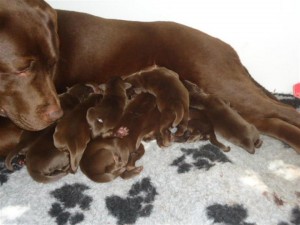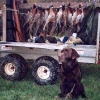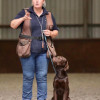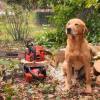After Whelping – Worries and Concerns…?!
(Or, the questions I’m most commonly asked at this very stressful time….!)
If you asked ten different breeders how they would tackle ten different problems, you would get one hundred different answers. However, in a ‘question and answer’ format I’d like to tackle the most frequently asked questions I get regarding care of the bitch and puppies AFTER a whelping in the first two weeks or so. These are in no particular time order after birth. This is not a ‘how to guide’ this is a ‘how WE guide’, so tweek as you see fit!
Please also see our article on ‘feeding’ a bitch after whelping, http://www.wylanbriar.com/breeding-advice/feeding-a-pregnantwith-puppies-bitch/
REMEMBER: A litter IS a worry. Few go plain sailing start to finish. But if you remember up to week 3 at least YOU are the breeder and NOT the mother of the litter. YOU keep her fed, watered, cleanly housed and a calm atmosphere around her and she will do the pups. If you go into it too heavy handed, YOU will turn into being mum and she will look to you for command which is exhausting and confusing and utterly unecessary. Do not let her flounder, gently suggest help here and there if necessary, but do not take over!!
Q: ” How do I know if she has finished/all the pups have arrived?”
A: You don’t. Not without a vet Ultrasound or Xray, but few bitches actually need one of these in all reality. There is a ‘limbo’ stage where pups have stopped arriving regularly, maybe mum has settled down with the litter, and she looks MUCH smaller than she did. By asking her to stand up and feeling, pretty firmly around her stomach with your hands, running them in the same places at the same time so you can ‘compare sides’ can sometimes tell you a lot, but everything is pretty bloated and swollen in there at this stage. generally if she has been whelping fairly happily, and looks a lot smaller, and you can’t feel a specific lump still on one or both sides, and she has accepted some light food, and you have taken her out and given her a really good trot round the garden and she has emptied out…. shes probably nearing the end if not AT it. Only time will tell if anymore will be born. Pups can come anything up to 24/36 hours after the percieved end of whelping and still survive, but more usually if its more than 4 or 5 hours they do not. Some breeders take the bitch as a matter of course, to have an Oxytocin shot to make her have a few contractions and shift through anything ‘lurking’ in there she cannot shift naturally. its never a BAD idea but if she seems settled, happy, eating, not unduly hugely stressed, I would just let time roll in and see myself. ANY idea that ‘someone’ is ‘still in there’ then go and have a scan or oxytocin jab and it will of course answer your question. With a settled bitch, after 3 hours we declare ‘war over and clean up. Occasionally an extra head is counted soon after, but more often than not, if you have the feeling she is done, and SHE has the feeling she is done…. she is done.
Q: My bitch has definitely finished labour, but is still panting extremely heavily, really rasping panting, is this normal She also still digs sometimes and is losing a LOT of discharge….?
A: Yes entirely normal. Some bitches pant more than others after whelping, and some pant for longer. Some pant extremely heavily on and off for 3 – 4 days after whelping, some have spells of it even after that, especially at night when laying down with the pups. ALL will lose ‘gunk/blood/discharge’ for quite some days after birth. it will vary a multitude of colours. None particularly = ‘bad’. Its all just clearing out. But the only thing is that does indicate ‘abnormal’ is if the discharge smells ‘bad’ or ‘hugely fishy’. Consult a vet if that occurs. Some bitches pant heavily as they lose discharge…. that is entirely normal especially if the pups are on and feeding. Like a human breastfeeding, as the pups suck it is pulling her womb back to size, so she will pant, and she will, even, possibly dig the box up, or behind the sofa or dinning room table, as she believes she is having new contractions. But of course, she is not, its just everything getting back into shape inside over the course of a week to ten days. So almost any amount of blood or gunk is normal. Some lose more than others. Size of litter does not always indicate how much blood/gunk will be lost afterwards. Small litters can have ‘a lot of padding in there’! Not just big ones.
Q: How often should I change the bedding/paper in the whelping box?
A: We tend to have a very simple system, obviously influenced by if it LOOKS excessively dirty at some point, then of course it gets changed more often.
Weeks 1 and 2 – Change and clean it once a day.
Weeks 3 and 4 – Change and clean it twice a day.
Weeks 5 and 6 – Change and clean it three times a day.
Weeks 7 and 8 – Change and clean the living quarters 4 times a day.
Q: How do I know each puppy is feeding equally? Should I rotate them? With big litters should I bottle feed so I know they are all getting equal?
A: Ok, OUR answer to this is… don’t. Unless you have a bitch showing she is not enjoying being a mother at ALL, or a litter over 12 puppies in size, I would not be interfering or starting to try and monitor who gets what, giving some more with bottles or rotating pups. Pups are clever, if they are healthy they will feed all they need. Smaller puppies will actually need LESS than big ones so its important that you don’t ‘force the issue’. Pups are instinctive so will feed as and when they fancy, you can often try and bottle feed a puppy that infact an hour before had a decent suck off Mum, and it refuses. You sit there in panic and tears saying ‘its dying its dying! It won’t take the bottle!’ and infact its just not hungry!! Most healthy puppies, with a mothers milk bar available, will be VERY reluctant to take a bottle, they know proper stuff is on offer, so if I was to say in 20 litters we have had to bottle feed once, it might give you an idea of how few litters actually need bottling…. Every now and then if you have really small puppy, and mum has just gone into the whelping box to feed, by all means let a big pup grab a big back boob and get the milk flowing, then tug him off and put him on a front one and pop a smaller pup on the big back one. But DON’T MAKE AN OBSESSION OF IT!!! Big pups NEED more food!! You are more likely to lose a big pup by trying to steal all HIS nutrition by forcing small pups to take the best pickings.
Q: My bitch doesn’t want to go near the pups!!
A: OK. Stay calm. The pups have been feeding constantly inside her so each has at least 3 or 4 hours after it is born when it can go without food. So don’t stress her by forcing pups on her. Some bitches need to only have one or two pups introduced to her at a time. They mentally cannot cope with you shoving 6 pups at her… MANY bitches, especially maiden bitches have absolutely no idea what to do with their first pup born. They will often think they have, infact, soiled themselves, and run away from it. And if you break the sack and cut the cord and thrust it at her, will growl and panic. So just remain calm, have a hot box standing by, and le her chill and relax and don’t force her to motherhood. Most bitches after a couple of pups start to show a vague interest in the squeaking little things. There are many emergency measures you can take if things go BADLY wrong and she utterly rejects all pups, but if that happens consult me if i’m your stud dog owner or your stud dog owner (and, if they don’t know consult me – grin! But they SHOULD!!). Have a very sing songy voice, and get rid of anyone other than yourself and a quiet radio. Do NOT whelp with an audience. A quiet, out of the way companion is fine, but this is private, dignified and not a public spectacle, respect that. Also make sure the whelping box is somewhere she is familiar with, NOT stuck in a spare room or somewhere she feels ‘banished to’. It makes all the difference.
Q: My bitch keeps picking the pups up and carrying them somewhere else!
A: She is feeling stressed and the place her whelping box is, is not making her feel private and secure. Some are more ‘wolf mothers’ than others. Some accept any artificial situation and cope/bounce. Some, more sensitive souls do not. LISTEN to her. If she is picking pups up and trying to take them elsewhere, or giving you clear stress signs. React to this. Turf out hangers on. Tell children they need to both keep quiet and keep away for a while whilst she learns the job. Do not handle the puppies at all even if the box needs changing. Calmly force her to stay in the room that you feel is genuinely acceptable for the whelping box…. its familiar to her… its warm…. its quiet….. sit back and watch but don’t let her go elsewhere. chances are she will slowly stop panicing. Take her out for a few short walks, it will clear her mind, let her relax and lose a lot of ‘hanging on discharge’. It often helps in a stressy mother situation.
Q: How separate should I keep my other dogs?
A: As separate as she feels the need. I keep the bitch completely separate for the first 48 hours after whelping. This can be a change of routine for the resident other dog/dogs but that’s just *tough*. Then I make sure there is a barrier between the whelping box and the presence of any other dogs for another couple of weeks, but I play by ear how happy she is to have other dogs near her and the other side of this barrier. usually pretty happy but if they shove noses over they get snarled at or chased off 🙂 that’s normal. even if you own ‘dad’ don’t kid yourself she recognises that….. give her as much space as she needs, respect any personality changes she has, and know they WILL pass, but whilst its good to have her back with your other dogs and her usual mates, her head is elsewhere right now and she may react well out of character. your dogs will understand this if it happens FAR more than you will and will ideally respond to it. NEVER leave her to defend a whelping box from visitors in the early days. She may take that stress out on the puppies.
Q: My bitch is in and out of the whelping box… I thought she should want to stay in there with the pups??
A: Some do. Some don’t. The girls who don’t we call ‘career mums’ 😉 If you allow them to, they do a perfectly good job but without being entirely ‘doting’. As long as you have the room at a reasonable temperature, and you keep mum well fed and watered, she will go in when the pups need her to. She needs to learn how to judge this but she does it best without your interference, because YOU don’t know any more than SHE does as you can’t speak ‘pup’ 😉 Pups moan and wail and twitch and groan but it doesn’t mean they are genuinely hungry. If you watch her and allow her to learn to be a mother in the immediate first few days, she will recognise when they make hungry signs and she will go and fulfil that. If you force her in at other times when they are not genuinely hungry she will not learn the signals. If you can, back off 🙂 Don’t ‘leave her alone’ but don’t ‘interfere’. A rule of thumb is that if she has not fed for 4 solid hours then in the first 3 weeks she needs to go in. But give or take on that. If the pups are quiet and settled then she does not need to be in there and she KNOWS that!! READ your pups and read your bitch!
Q: Everything was going FINE! Then day three I have lost a puppy. Are the rest about to follow?
A: Day three is the classic day to lose a pup or puppies that have not formed completely perfectly inside. they muddle through the first couple of days based on their body weight from feeding intravenously, then faced with feeding and coping 100% themselves, any with problems tend to last 3 days and then slip away. its tragic, but its common. Know there was nothing you could do and whatever was wrong would of occurred at another time and taken the pup.
Q: How soon should walks recommence as my bitch seems to be keen to come with my other dogs?
A: We resume walks with our dogs from as soon as a bitch fancies rejoining them. This can be the first day or a week into pups. Germs are overrated 😉 😉 Her mental state of mind is far far more important. Most bitches are better mothers for coming out for 20 minutes for a normal walk, having a quick wipe with a cloth with weak Dettol on it over the ‘milk bar then back with the pups. Infact after a couple of days I am quite firm that mum comes out for a five or ten minute wander at least. A mother who is struggling in any way with the job benefits hugely from knowing there is an outside world again! They quite often settle to the job better for a few short walks.
Q: How to identify pups? How often should I weight them?
A: I am not a fan of coloured collars, identifying pups etc etc. IF a pup gives cause for concern I dab a little tippex on it in a visable place, a reasonably vigalent breeder will note if a pup is failing compared to the others without a pink collar telling them so, its very easy just by eye. Otherwise pups remain unidentified till about 6 weeks when I place tippex spots on them in different places and then, based on those spots, make personality notes to help owners choose their puppy on taking home day! I weight my pups on about day 2. Pups often lose weight from birth to about day 2 or 3 which worries breeders senseless!! So I have learnt that pups are what they are, weight them on day 2 or 3, and then, personally we don’t weight them again till we need to worm them on week 3. Not out of a lax attitude to detail, but because pups will go up and down, and some will be big, and some will be small, and you cannot start trying to counter that because nature is fantastic! I weight then to administer wormers at 3, 5 and 7 week and that’s it. But some breeders weight all the time, sometimes twice a day. it would drive me INSANE, but if its a record you like keeping, then who am I to stop you. I can say it often causes more worry and complications than it should though if you do weight all the time, as each pup will progress as it progresses.
Q: How soon should I allow visitors?
A: OK, I tend to only allow people my bitch REALLY knows to visit in the first two weeks. Doesn’t mean people don’t come and go, its not an exclusion zone, they just don’t get to go in close to the pups. If mum wants to come and make a fuss of the visitor though, that’s all good! I absolutely do not allow children to come who might make lots of noise. This is very worrying for her. If I need someone to help me to puppy sit of course then ideally its someone she knows anyway. Have that person come in slowly and see the reaction. I allow puppy buyers to come just to come see pups, and cuddle a few, around the 3.5/4 week mark. From then I find the bitch really doesn’t mind. Neighbours/family/friends of friends that would love to see little babies get shelved till bout week 3 too. Then they need to be calm, and react accordingly if the bitch tells them to sod off 🙂 However I am in no way an old fussy hen about taking shoes off, wearing boiler suits 😉 😉 There is just no need for it in 99% of cases, we would walk germs in from the garden so a visitor, unless they actually have a ill animal at home, is welcome without making them shower in antiseptic first!! Obviously you have to be sensible, but pups NEED to build a good immune system, there is no point in wrapping them in cotton wool. IF something tragic sweeps through the litter you are the unluckiest person in the world and will never really know the *source* of it. Chances are it wasn’t muddy shoes!! You are more like to lose pups to DRAUGHTS rather than GERMS.
Q: Do I have to sit up and watch my litter 24/7?
A: No. You are only human. A puppy being laid on does not make a sound because the fact is, it can’t breathe or it would alert us!
We sleep next to the whelping box from day 1 to day 10 or so (and we do SLEEP, this is not to stay awake watching like hawks). We are then placed so we can pop and let the bitch (who is having loads of food and drink!!) out at a moments notice during the night, fish out the odd pup who has wandered behind her and started yelling about it, and feed her in the night. I hasten to add this is all based on care of the bitch… NOT trying to stop pups being laid on. That is simply impossible. I have known people get pups to 3 weeks of age on a strict 24/7 awake rotational regeime, and then lose one whilst just popping to have shower!! We do not use pig rails and we do not force ourselves to stay awake 24/7, it makes for a much stressier experience for all involved if you do. The choice on pig rails is I like my girls comfortable in there. Our whelping boxes are 4 foot x 4 foot. Its the reason I don’t use heat lamps, I feel the heat above is too intrusive for the BITCH. I like to just use a often renewed hot water bottle under the vet bed. Cheap, easy to renew and the girl can easily lay away from it if she wants. BUT it also depends on the temperature of the room. Ours has a oven in there right next to the whelping box so its easy to heat the room up a bit. If its a kennel or cold place a heat lamp would be essential.
Q: How do I know if my bitch has enough milk!
A: People misjudge bitches boobs 🙂 The milk bar gets bigger as demand increases, so just because its reasonably small flat and tidy at the start doesn’t mean there isn’t enough milk coming down. She will soon look like a cow with udders believe me by week 3! We supplement our bitches with small bowls of warm, watered down puppy milk with glucose powder in four or five times a day to keep fluid flowing through them. Its not essential but it sure helps the production of milk as we all know, its fluid that counts rather than food to a greater extent. Pups don’t feed forever, they take short meals multiple times a day. Don’t expect them to dangle constantly from her as they won’t. They tug and moan a LOT getting the milk flow started and when it starts to cease. Don’t be fooled by this, they will soon give up, wander to a heat source and fall asleep.
Q: Should I take mum and Pups for a vet check after whelping?
A: I wouldn’t. Not unless you have a solid gold reason to. The last thing you need is her running into a dog with kennel cough or something in the waiting room. If a vet will come to you, fine, but generally they will sweep their eye over the pups and say ‘they’re nice!’ and charge you £35 🙂 So unless you are genuinely worried about something, there really is no need.
Q: My puppies have loose stools at 5 days/10 days/2 weeks etc… Should this worry me?
A: Medically, possibly. Realistically, no. Its wonderful if pups poo little solid stools from day one. And of course ANY puppy that is lifeless, no round belly or seperating itself off on a regular basis looking *different* needs vet attention, (if possible, vet to YOU, but difficult of course). However, pups poo out what mum gives them. Really rich milk will make them loose. Milk based on her eating something dodgy in the garden/on a walk will make them loose. Her eating too MUCH will often make them loose. Their poo can often have little round seed type things in it from just a few days old. This is fat particles and nothing to be worried about. Generally you are hard pushed, with a good mum to see much poo in the first couple of weeks, you just see stins on the bedding where it *was* but sometimes you hear that ‘squirt’ noise that a pup makes when loose. We tend, if this occurs, to water down her puppy milk even further so its all nearly water…. we tend to ensure she is getting no titbits from anyone that might be going through to the pups (once a stud client thought back and realised they have given the bitch the remains of their curry the night before!!), and after that, if everyone is cheerful, buzzing and bright, we don’t worry.
It will all sort out once weaning starts and we can monitor how much each pup is getting. It tends to be the bigger pups that get the squirts anyway, so they are ‘probably’, just like in later life when pups get the runs, having too much food. Being greedy basically 😉 I would not want to see blood in the poo at this sort of 0 – 3 week stage. More than one motion seen with blood in it at THIS age, would have me ringing the vet even if I don’t end up taking the pups there.
Copyright: Diana Stevens – March 2013.
Wylanbriar Labradors








